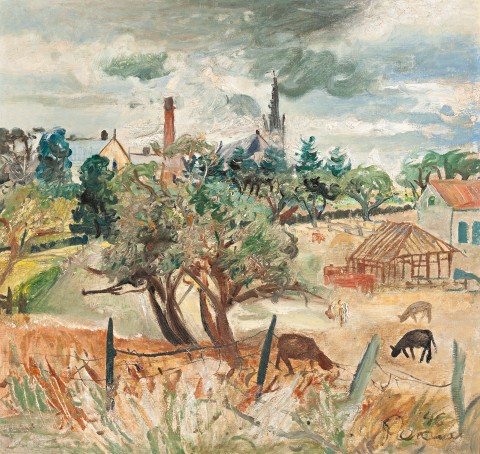OAKLEIGH LANDSCAPE, 1946
JOHN PERCEVAL
oil on canvas on cardboard
65.5 x 69.0 cm
Andrew Ivanyi Galleries, Melbourne
Private collection, Melbourne
Allen, T., John Perceval, Melbourne University Press, Melbourne, 1992, pp. 106 (illus.), 150
In 1946, the Melbourne suburb of Oakleigh, 15 kilometres south-east of the city, was comprised of orchards and small farms interspersed by a complex of industrial brickworks. The first of these was established as early as 1857 when it was discovered that the area contained large deposits of high quality clay.1 John Perceval himself was also reliant on clay at that time for use at the successful AMB Pottery, which he was running with his brother-in-law Arthur Boyd one kilometre away on busy Neerim Road. He was also creating a small series of paintings, his so-called ‘religious old masters’, which depicted biblical events set within the urban environment of Melbourne, and in semi-rural situations inspired by Murrumbeena and Oakleigh; and Oakleigh Landscape, 1946 is directly related to these significant images.
Perceval was the youngest member of the ‘Angry Penguins’, a group of artists which included Sidney Nolan, Albert Tucker, Joy Hester and Arthur Boyd. Whilst the geographical nucleus of the group was Heide, the farm at Heidelberg owned by the mentor-patrons John and Sunday Reed, Perceval and Boyd were more firmly centred on the latter’s family property ‘Open Country’ in Wahroonga Crescent, Murrumbeena. This shambolic, overgrown compound had been established by Boyd’s parents, Merric and Doris, in 1913 and was a suburban wonderland for generations of bare-footed children. Perceval had a troubled childhood so when he met Boyd in the army in World War II and subsequently married his sister Mary, it was as if he had discovered his own idealised family. Merric Boyd was Australia’s first studio potter and the ceramics training he passed on to the younger men planted the seed that became AMB (Arthur Merric Boyd) Pottery which opened in a former butcher’s shop in 1944.
At the same time, Boyd and Perceval became absorbed in studying the influential technical manual Materials of the Artist and their Use in Painting by Max Doerner. Through this, they sought to emulate in their own paintings the rich colour and glazing of Dutch masters including Rembrandt and Breughel, and Perceval was particularly inspired by the latter’s rustic, bucolic scenes of peasant life. As part of the process, he painted a suite of paintings of locales near Murrumbeena and a number, including Oakleigh Landscape, feature the prominent brickwork chimneys. Others in the series are Brickworks at Oakleigh, 1946 (private collection), Cabbage Field, Oakleigh, 1947 (private collection) and Oakleigh vegetable garden, 1947 (Benalla Art Gallery, Victoria).
Oakleigh Landscape is painted with Perceval’s trademark vigour, but he took pains to dismiss the notion that he was somehow a haptic painter, slapping paint on in an expressive manifestation of ‘joie de vivre’. Instead, he argued, ‘my work is primarily a response to the subject, to light and trees, air, people etc. Whatever success it may achieve is due to the desire to equate the vitality, the pulse of life in nature and the world around us’.2 In works like Oakleigh Landscape, this attitude is on full display as is his technical prowess indicative of his deep study of the painterly techniques of the northern European masters.
1. Until 1953, the area supplied twenty per cent of Melbourne's bricks.
2. Perceval, J. quoted in Reed, J., New Painting 1952-1962, Longmans, Melbourne, 1963, p. 24
ANDREW GAYNOR
